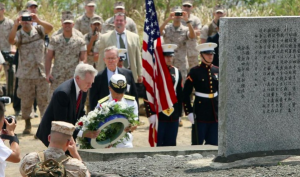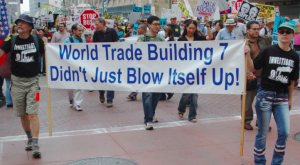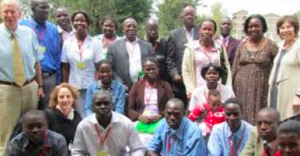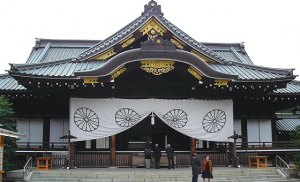By Alex Kim
Research Question
How do people feel differently towards, and commemorate, the deceased victims of a natural disaster versus a disaster caused by human actions?
Introduction
In this blog, I intend to go over the main differences between how people honor the dead victims of a natural disaster versus a disaster caused by humans. I intend to observe and analyze first how people react to and commemorate the deceased from human-caused disasters and then move on to people’s reactions to, and commemoration of natural disaster victims. I will further observe the different perspectives the insider (such as a person who has lost a family member) holds compared to an outsider (someone who was not affected by the disaster), by examining people who lost their family members in the September 11 attacks, and also by observing the symbolism of the Yasukuni Shrine, from the Japanese and other countries’ points of view. My project will primarily be based on the Japanese people, society, and culture, but I also plan to investigate events in other countries and their perspectives, to better make a clear comparison with Japan. I will post both videos and photographs so that you can feel deeply about my project. So, welcome to my blog, and I hope you enjoy it!
The Truth About the September 11 Attacks?
The September 11 attacks can arguably be seen as one of the deadliest terrorist attacks not only in the U.S, but the world. Two planes flew into the towers of the World Trade Center in New York City, a third plane hit the Pentagon right outside Washington, D.C., and a fourth plane crashed in a field of Pennsylvania.[1] Over 3,000 people were killed due to the attacks in New York City and Washington D.C., including more than 400 police officers and firefighters.[2] As a result of the attacks, Operation Enduring Freedom began, which is the American-led international effort to take out the Taliban regime in Afghanistan and destroy Osama bin Laden’s Al-Qaeda terrorist network.[3] Interestingly, while there were initially many Americans who supported retaliation against the Al-Qaeda terrorist group, people started to show a lack of support over the years, including those who lost their family members through the attacks.
Below is an interview that We Are Change, an independent media organization, conducted with Max Dickson during the 10th anniversary of 9/11. Dickson is a World Trade Center survivor, who was about two blocks away from the World Trade Center during the attacks. His uncle worked at Cantor Fitzgerald on the 110th floor of the North Tower, where he unfortunately passed away that day.
A Short Summary of the Interview:
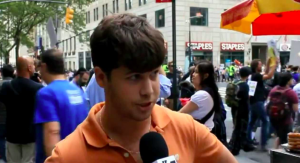
Max Dickson interviewing with We Are Change during his 9/11 truth movement protest in New York City.
Video: https://www.youtube.com/watch?v=ydOdRt4rHSY
9/11 Family Member: “I Get Used as a Sacred Cow.”
Max: “…I personally support the 9/11 truth movement… the event basically woke me up to the reality of what goes on in this world, such as how did Building 7 fall since nothing hit that building, what happened to all the black boxes, and it just seems like Al-Qaeda is just a CIA asset. Apparently, the CIA met with Bin Laden two months before the incident, and I’m not talking out of my ass, it came out in The Guardian on October 9th I believe. Also the fact that we are helping Al-Qaeda now to “restore Libya” and all, and all these kinds of stuff.”
Interviewer: “And I have to say that a lot of people who are critical against people who are seeking the truth behind 9/11, one of the major things they use against us is that they are saying that we are being disrespectful to the family members and the survivors. How do you feel about that?”
Max: “I kind of feel like I get used as a sacred cow. Like you hear Bill O’Reilly talk about the victims’ families more, but you really see how full of crap they are, because they had a victim on their show who lost a son, and Bill O’Reilly just told him to ‘shut up, you’re a disgrace to your father who died in 9/11,’ and it just really shows you that this is all a propaganda machine.”
Interviewer: “And he was an anti-war guy right?”
Max: “Yeah, he was an anti-war guy. And I just don’t like how much of a Nazi symbol this got turned into, like a crystal knot kind of thing for the government to get its way, and I see America turning more like a factious police state everyday. I see CNN becoming more like Italian or German newspapers back in the day (World War II), and it’s really sad and I feel sad to be part of this country at this time, because I feel like I’m part of a imperial power, since I feel like my country kills millions and millions of innocent people. It’s just a real shame and it’s not what the founders wanted.”
Interviewer: “And it’s also a shame how you guys are used as a ploy to justify the war?”
Max: “Absolutely, I think it’s really disgraceful and we need new media. We need guys like you. I personally have a friend of mine, and we are starting a news organization. I just want to contribute to it as much as I can, and make no judgments. I’m not blaming whoever did whatever. It’s just kind of human nature, and we’re just going along with the flow. I’m just here to spread the word and wake people up as quickly as I can.”
This interview emphasizes the interesting role the 9/11 dead victims are playing, as Max thinks that they, including his uncle, are being represented in an unfair, unjustified, and immoral way by the U.S. government, by using them as one of the reasons to be in a war with the Al-Qaeda group. Simply put, Max indicates that these dead victims are inevitably symbolized to be the ones who started the war in Afghanistan. This scenario represents a complex situation of commemoration of innocent civilians, because these civilians most likely did not have any intentions of staring a war between countries, but were just unlucky being caught up in the 9/11 attacks. The interview emphasizes that the political response of the U.S. to the 9/11 attacks is corrupting a proper way to honor these victims, which is through peace and diplomacy rather than violent war.
Furthermore, I found Max’s statement compelling when he states in the interview, “I feel like I get used as a sacred cow,” considering that he is a family member of a dead victim of the 9/11 attacks. I expected Max to express anger and vengeance towards the Al-Qaeda group, but he makes it clear that the war against them is what the government wants, not what he or other victims’ family members want. Certainly, one can argue that the government has the strongest rights and power to decide what they should do about the 9/11 attacks, since it is a national security issue, but people can also argue that the U.S. government does not have the right to use the dead victims as the “reason” to go to war in Afghanistan. If the dead victims were U.S. soldiers who were already at war with the Al-Qaeda group, perhaps then it becomes a more suitable reason for the U.S. to justify their deaths, but these victims included ordinary U.S. citizens who were simply just going on with their lives in a peaceful world. On the whole, the interview emphasizes the controversial roles of the dead victims, whereby the U.S government wants to commemorate the dead 9/11 U.S. victims by starting a war, but the citizens, including the victims’ family members, suggest that commemorating the 9/11 U.S. victims in this way is disrespectful, disgraceful, and improper.
Other Ways the Family of a 9/11 Victim Honored the Deceased
So I now want to ask this: if the government’s way of commemorating the 9/11 victims by going to war in Afghanistan is wrong, what are the right ways to commemorate them? Below is a story (short video) of what Elizabeth and Stephen Alderman have done to honor their 25 year-old son, who died during the 9/11 attacks.
Video: http://archive.lohud.com/VideoNetwork/1148018488001/9-11-Stephen-and-Elizabeth-Alderman
“9/11 Stephen and Elizabeth Alderman” by Joe Larese
This video primarily emphasizes the amount of power a family has in creating its own memorial service for their dead family members. I found it incredible when the parents said that they would help one billion people around the world who have experienced torture, terrorism, or mass violence, and who can no longer lead functional lives because of traumatic depression and post-traumatic stress disorder (PTSD) in Peter’s name.[4] The way in which the family decided to conduct the memorial service for Peter does not only benefit them emotionally, but also has a significantly positive impact towards countless numbers of lives in the world. Elizabeth Alderman says in the video, “there is nothing that we can do to help Peter, but if we can help return these people to life, it would be the perfect memorial for him.”[5] This statement made me realize that the ideal commemoration can be heavily individualized, but as long as the people feel good and feel like they are making a difference by commemorating the dead victims, they can alleviate their negative emotional feelings towards the deaths of their loved ones. Hence, it can be inferred that commemoration here is positively and efficiently used to make Stephen and Elizabeth Alderman feel emotionally better after losing their beloved son, which is shown to be a big step in allowing them to move forward with their lives.
Moreover, when the Aldermans were often asked by people, “Why are you dealing with traumatic depression and PTSD when there are so many greater problems in the world?” they responded back by saying, “Billions of philanthropic dollars go into fighting HIV/AIDS, malaria and poverty. But if people don’t care whether they live or die, they will not follow through with their medication regimens, walk that extra mile for portable water or take advantage of microfinance. If you can restore hope, a person is less likely to strap on dynamite and kill innocent people.”[6]
This response emphasizes the importance of possessing hope after losing someone close to you after a disaster like 9/11. Stephen and Elizabeth Alderman are in fact shown to have gained hope by doing their work, as it has kept them functioning and given them a reason to get out of bed every day.[7] Their intention to “leave a profound and indelible mark that Peter existed on this Earth” has functioned as a way of commemorating their son, and this is shown to give them a new meaningful sense of purpose to their lives. On the whole, Stephen and Elizabeth Alderman’s response is very different from the U.S. government’s response, because the dead victim in the Alderman’s case became a positive and influential symbol that is constructively spreading a good cause for the world, whereas the government is harming the representation of the 9/11 dead victims, as the victims are treated like a war symbol, by using them as an “excuse” to start a war in Afghanistan, resulting in the deaths of many more thousands of people.
The Controversy of the Yasukuni Shrine
The Yasukuni Shrine is a Shinto shrine in central Tokyo that commemorates Japan’s dead soldiers, colonists, and others who served the imperial expansion.[8] The shrine was founded in 1869 with the purpose of enshrining those who sacrificed their lives fighting for Japan, including in the Satsuma Rebellion, the First Sino-Japanese War, the First World War, the Second Sino-Japanese War, the Pacific War and other wars.[9] However, even though the shrine seems to be the right place for the Japanese to honor their dead, it has raised many international concerns, especially from South Korea and China. The reason is rather straightforward: the shrine honors Japan’s war dead, including 14 individuals convicted of “Class A” war crimes, and include Hideki Tojo, the general of the Imperial Japanese Army and the 40th prime minister of Japan during much of World War II. These Japanese military leaders carried out various atrocities in Korea and China during the war, including the widespread use of “comfort women,” or sex slaves forced to serve Japanese soldiers.[10] Hence, whenever important and powerful political figures in Japan visit the shrine, it becomes a major issue that shakes diplomacy with China and South Korea, because they are also paying tribute, whether they intend to or not, to an imperial order in which Japan violently treated its neighbor countries.[11]
For example, South Korean officials, including the foreign minister, cancelled their visit to Japan in protest over the pilgrimage and Japanese Prime Minister Shinzo Abe’s visit to the shrine.[12] Japanese lawmakers also had to cancel their trip to China after this incident, because Xi Jinping, the General Secretary of the Communist Party of China, was apparently being “too difficult” about setting up meetings by warning Japan that they had to pay a heavy cost for the visits.[13] Even more interestingly, a Chinese restaurant owner became a minor celebrity on the Chinese Web for putting a sign that said “Yasukuni Shrine” over the restaurant’s toilets.[14]
So what does this tell us about commemoration considering the fact that Japanese politicians continue to visit the Yasukuni Shrine despite the risk of ruining its diplomatic relationships with South Korea and China?
The answer is still not absolutely clear, but some people think that politicians visit the shrine to strengthen nationalism or for their own political gains in office.[15] While this may be true, I also believe that Japanese Prime Minister Abe’s commemoration of these war criminals and the resulting strong reactions of China and South Korea against his tribute highly relate to human nature. Joshua Searle-White in his book, The Psychology of Nationalism, states, “All nationalists carry strong attitudes and beliefs about their own people and about others, who feel their attachment to their nation passionately, and who even, at times, act with great cruelty against their enemies.”[16] Thus, from a socio-psychological perspective, his statement implies that nationalist sentiment is greatly caused by the citizen’s attachment and identity with his country.[17] In this way, looking from the Japanese point of view, the citizens naturally are more likely to give Japan the benefit of the doubt and visit the shrine to honor even the most notorious military officers of Japan such as Hideki Tojo, even when these officers may have caused great suffering to China and Korea during World War II, because they have been raised to love, serve, and defend their country no matter what the situation. This socio-psychological perspective can also relate to South Korea and China’s resentful reactions, since their countries’ citizens also possess national pride and want to show their love for their country. Thus, it is understandable that the Chinese and the Koreans possess almost no respect and empathy for Japanese politicians paying tribute to “Class A” war criminals at the Yasukuni Shrine, since these dead victims caused countless numbers of Koreans and Chinese to suffer greatly during World War II.
Below are some pictures of the Yasukuni Shrine-related incidents:
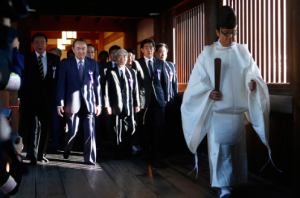
A group of politicians including former Minister of Health, Labour and Welfare, Hidehisa Otsuji, are led by a Shinto priest as they the visit Yasukuni Shrine.
(http://www.ibtimes.co.uk/japan-pm-shinzo-abe-sends-offering-yasukuni-shrine-angering-china-south-korea-1470538)
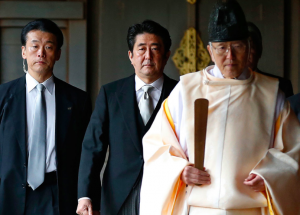
Japanese Prime Minister Abe is pictured during his visit to Yasukuni Shrine on 26 December, 2013.
(http://www.ibtimes.co.uk/japan-pm-shinzo-abe-sends-offering-yasukuni-shrine-angering-china-south-korea-1470538)
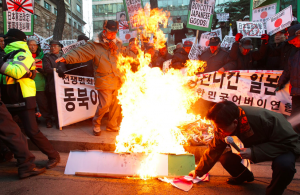
South Koreans burn a Japanese flag and effigy of Prime Minister Abe in front of the Japanese Embassy in Seoul on 27 December, 2013 after Abe visited the controversial shrine.
(http://www.ibtimes.co.uk/japan-pm-shinzo-abe-sends-offering-yasukuni-shrine-angering-china-south-korea-1470538)
-This image shows how a simple act of honoring a notorious dead victim can still enrage the people today, indicating the political influence dead victims can still hold through their commemoration.
And below is a link to a quick video that shows one around the Yasukuni shrine:
https://www.youtube.com/watch?v=1BcKWtk-Cpk
Watching this video allowed me to gain a deep sense of what it feels like visiting the Yasukuni Shrine. I felt that the whole area of the shrine was very peaceful and dominated by nature. One thing I found amusing was how there were no hand towels at a place where people washed their hands. When the person in the video described that the sign on the gate of the shrine is a symbol of the Japanese imperial family, I felt that the Yasukuni Shrine is indeed an extraordinary, meaningful, and sacred place in Japan. The shrine seemed like an entertaining place to visit, as there is a place to donate and wish for whatever one wants to pray for and also because one can participate in playing O-mikuji, which are random fortunes written on strips of paper. I thought it was fascinating that the shrine honored all the dogs and horses that died in war by erecting statues of a dog and a horse, because I feel that people often forget that animals also play important roles in wars. On the whole, I thought that the Yasukuni Shrine was an incredible and a huge place (and yes, even though I may be from Korea, I am being unbiased here!), that seems to give a very peaceful vibe, in contrast to all the hostile international problems it has caused.
Commemoration of Natural Disasters: The “Miracle” Pine Tree
The “miracle” pine tree is a pine tree that became a symbol of hope after it survived the March 2011 tsunami in Rikuzentakata in the Iwate prefecture in northeast Japan.[18] This 250-year-old pine tree was the only tree among 70,000 trees left standing along the town’s coastline after the disaster, in which an estimated 1,700 people died in Rikuzentakata.[19]Despite the damages the tsunami caused, the pine tree continues to give hope to the victims who survived and is lit up every night as a mark of respect for the victims.[20] The pine tree had to be moved in September 2012 after its roots died from exposure to salt water, but was returned to its original location in June 2013 after being taken care of by specialists.[21] Below is a video that clearly shows the surroundings heavily damaged by the tsunami, but also reveals the incredible sight of how the “miracle” pine tree is still standing after taking the hit by the tsunami:
Video: https://www.youtube.com/watch?v=Cz-TRvw0YZo
“Rikuzentakata Miracle Tree”
The video was filmed roughly a month after the tsunami hit the town. The clip shows a clear view of the destroyed buildings, roads, and other trees, which notably makes the “miracle” pine tree stand out. After watching this video, I started to gain an understanding of why people viewed this pine tree as a symbol of hope in recovering from the 2011 disaster; it’s just a very miraculous sight seeing a pine tree stand so tall and straight when all the other parts of the town were destroyed. 67-year old Mr. Matsuzaka, a retired teacher who makes the journey from his temporary house in the hills several times a week to see the “miracle” pine tree, even said, “When I see the pine tree, I feel that our city can revive,” which indicates the optimistic and powerful role the pine tree plays for the victims who are still alive and are trying to get back on their feet.[22]
So How Does the “Miracle” Pine Tree Give People Hope Without Reminding Them About the Deceased Victims?
Even though the “miracle” pine tree primarily functions to give hope to the survivors of the March 2011 tsunami, it also signifies an important and an intriguing sight: people greatly desire the pine tree to remain there, even though it can remind them of their deceased family members or people they were close with. In fact, thirty of Rikuzentakata’s children under 16 were orphaned, while 150 of them lost one parent.[23] But even the town’s mayor, Futoshi Toba, whose wife died in the tsunami, said at a ceremony, “For those of us who were left suffering after the disaster, the miracle pine gave us the strength and hope to carry on living.”[24] This statement implies how much the encouraging context can matter in symbolization; because people think of the “miracle” pine tree mainly through the perspective that the tree survived the tsunami hit, people possess the mentality that if the pine tree survived it, I can also survive and endure recovering from the disaster. Hence, the context of the “miracle” pine tree naturally allows the survivors to avoid getting depressed about their loved ones who passed away from the disaster, and strongly offers a positive, optimistic, and the best outlook of the disaster. The “miracle” pine tree points out that not everything related to a natural disaster reminds people of the discouraging, depressing, and worst perspectives of the disaster including lost family members or close friends, but that some things can constructively engage the survivors to rebuild their lives by giving them hope.
Below are some of the pictures of the “miracle” pine tree:

People comes to see the “miracle” pine tree during the last moments before the tree gets moved to another location for preservation in 2012.
(http://www.japantimes.co.jp/news/2015/02/27/national/montblanc-to-craft-¥520000-pen-made-from-miracle-pine-in-iwate/)
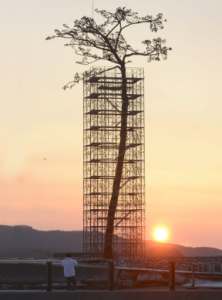
The “miracle” pine tree in 2015, currently undergoing anti-decay treatment to keep it standing as a symbol of hope for reconstruction and the resiliency of survivors.
(http://www.hellojapan.asia/en/travel-guide/miracle-pine-tree.html)
A Quick Flashback: Why Do We Remember Human-Caused Disasters Better than Natural Disasters?
I remember during the first week of the semester, Professor Bayliss and the class attempted to answer the question, “Why is it that natural disasters don’t stick in our consciousness of the past in the same way as wars, atrocities, and acts of terrorism do?” My response to the question was that it is because we cannot as easily gain significant and insightful lessons from them and humans do not have control over the occurrence of natural disasters. Thus, people feel worse about human-caused disasters because they feel that they could have done something about them to alleviate the damages, and it is easier to put the blame on someone else – allowing us to remember them more easily. However, when considering this aspect, ironically, it is shown to be more difficult for people to forget about their loved ones who died from a natural disaster than a disaster caused by humans.
The Psychological Similarities and Differences between a Natural Disaster and a Human-Caused Disaster
Dr. Asukia describes various psychological conditions he has seen in the survivors who have been overwhelmed by the tsunami. Dr. Asukai visited the city of Rikuzentakata, in Iwate prefecture, at the beginning of May as part of a team of specialists providing psychological care and emotional support for survivors.[25] Before the disaster, Rikuzentakta had a population of around 24,000, whereas after the disaster, the dead and missing reached around 2,000 (almost ten percent of the population).[26]The doctor states that families of the victims reach a big psychological turning point at between six months and a year after the event, but among those who grieve over the loss of a loved one for more than a year, there are a few who develop a condition known as “complicated grief.”[27] This condition occurs when the strong feelings of sorrow that the bereaved feels over the loss of a loved one continue, eventually to the point where leading a normal life becomes practically impossible.[28] But interestingly, Dr. Asukia notes that grief is not a sign of illness, but rather a normal psychological reaction, which we find in the majority of bereaved families and individuals in any situation in which the death of a loved one occurs.[29] In this way, “complicated grief” can be seen as a rather typical emotional condition that can occur for families of the victims in both natural and human-caused disasters.
Dr. Asukia further describes “acute grief,” which is more of a distinct psychological condition people can have towards the dead victims after natural disasters. Takagi Testuya, an associate professor at Kyorin University, interviewed a family who had lost their elementary school aged daughter in the tsunami, whereby the mother said: “Why did such misfortune have to befall me?” Hence, acute grief is shown to produce self-persecution, which arises when the survivor sees the fact that they survived when others did not, as unfair and even unforgivable.[30] Even though it is certainly possible for survivors of human-caused disasters to feel this way, such as for the 9/11 victims who survived, it can be more difficult for the people who lost their family members or close friends from natural disasters to commemorate them in a proactive and healthy way.
As cases in point, we looked at the U.S. government retaliating against the Al-Qaeda terrorist group after they killed thousands of innocent U.S. citizens, and also the Alderman family helping numerous number of people to honor their son who died during the 9/11 attacks and to stand up against the terrorists, mass violence, and torture. These two responses are productive ways of commemorating the dead victims, because both the U.S. government and the Alderman family feel justified when they carry out these actions; they were able to find a good reason and purpose to fight for justice for the deaths of the 9/11 victims, because they could see a clear enemy (the terrorists) to fight against. However, in the case of the March 2011 earthquake and tsunami, people could not see a clear enemy or find a rational reason why the disaster happened. People may indeed argue that the disaster was caused by nature, but we cannot declare war on nature nor do we have much power to prevent them; they are random, nonsensical, and often out of human control. Hence, recovering from a natural disaster seems to be more challenging than recovering from a disaster caused by humans, since humans feel defenseless and it seems illogical to fight against natural phenomena.
Conclusion/Reflection
On the whole, I believe that the ways commemorations are held are very different in the cases of a natural disaster and a human-caused disaster. Max Dickson’s interview emphasizes the complex role the 9/11 victims played towards the war in Afghanistan compared to the dead victims in the 2011 Tohoku earthquake and tsunami; some people believed starting a war in Afghanistan was the ultimate way to honor the 9/11 victims, whereas other people believed that it was very disrespectful to the victims, as this leads to more deaths of people’s lives. I believe it is indeed unfair to use the deceased 9/11 victims as scapegoats for the war in Afghanistan, as they were just innocent civilians who got unlucky in accidentally being involved in the terrorist attacks. Hence, the commemorations of the deceased victims from human-caused disasters seem to have a stronger and an on-going influence on the world, compared to the commemorations of the deceased victims from natural disasters, mainly due to political agendas and the national security concerns against foreign threats.
The controversy of the Yasukuni Shrine sounded logical to me. I was empathetic to all nations – Japan, China, and South Korea-thinking from the perspective of the psychology of nationalism, in which the politicians from each country are expected to act in the ways that best represent their countries. As an example, if South Korean officials did not cancel their visit to Japan after Prime Minister Abe visited the Yasukuni Shrine, they would be perceived to be people who showed great disrespect to the Korean victims who died during the Japanese occupation, which would portray their lack of patriotism and national pride in South Korea. Similarly, if Japan’s Prime Minister Abe also did not visit the Yasukuni Shrine at least once, he could also be viewed as a prime minister who is showing disrespect to the millions of soldiers who sacrificed their lives for Japan, which in turn could damage Japan’s national pride among its citizens. Thus, commemoration of the deceased war victims inevitably appears to be complicated for reasons of global politics and diplomacy, whereas commemoration of the deceased victims from natural disasters probably would not cause any political issues, as it is not a human-caused occurrence.
I found the commemoration of the victims who died from the 2011 Tohoku earthquake and tsunami disaster more fascinating than I had expected. The fact that the “miracle” pine tree had the power to lift some people up from devastation without reminding them negatively of the deceased victims touched on a big difference from the commemoration of the 9/11 victims. I felt that saving the “miracle” pine tree was a positive and healthy way of commemorating the dead victims in the area of Rikuzentakata, because it delivered a message to the victims’ families that even though you lost your loved ones, you can honor them by enduring the pain and recovering as best as you can from the disaster, whereas going to war in Afghanistan sent a message that more deaths of the soldiers and innocent people will bring honor to the deceased victims of 9/11.
Lastly, the psychological condition of feeling guilty that “I” survived and their loved ones did not seemed to connect to both commemorations of natural disasters and human-caused disasters, but the solutions seemed very different. I believe the Alderman family’s way of commemorating their son by helping one billion people around the world who can no longer lead functional lives because of traumatic depression and post-traumatic stress disorder (PTSD) was successful because, in honor of their son, they wanted to stand up against the terrorists and others who contribute to mass violence; however, the families of the dead victims of the 2011 Tohoku disaster would have less motivation to act in the same way, because natural disasters are spontaneous, neutral phenomena that humans do not have control over, and that makes it hard for the people to stand up against them.
Word Count: 5376
Work Cited:
[1] “9/11 Attacks,” http://www.history.com/topics/9-11-attacks.
[2] “9/11 Attacks,” http://www.history.com/topics/9-11-attacks.
[3] “9/11 Attacks,” http://www.history.com/topics/9-11-attacks.
[4] “9/11 Stephen and Elizabeth Alderman,” http://archive.lohud.com/VideoNetwork/1148018488001/9-11-Stephen-and-Elizabeth-Alderman
[5] “9/11 Stephen and Elizabeth Alderman,” http://archive.lohud.com/VideoNetwork/1148018488001/9-11-Stephen-and-Elizabeth-Alderman
[6] “9/11, How we honored our son’s memory,”
http://www.cnn.com/2012/09/10/opinion/alderman-september-11/
[7] “9/11, How we honored our son’s memory,”
http://www.cnn.com/2012/09/10/opinion/alderman-september-11/
[8] Japan’s no-apology diplomacy: Why a small Tokyo shrine is causing big trouble in Asia,”
[9] “Yasukuni Shrine,” http://www.japan-guide.com/e/e2321.html
[10] “70 years later, the world is still fighting World War 2,”
[11] 70 years later, the world is still fighting World War 2,”
[12] “Japan’s no-apology diplomacy: Why a small Tokyo shrine is causing big trouble in Asia,”
[13] “Japan’s no-apology diplomacy: Why a small Tokyo shrine is causing big trouble in Asia,”
[14] “Japan’s no-apology diplomacy: Why a small Tokyo shrine is causing big trouble in Asia,”
[15] “Japan’s no-apology diplomacy: Why a small Tokyo shrine is causing big trouble in Asia,”
[16] “The Everyday Psychology of Nationalism,” http://www.theatlantic.com/health/archive/2014/03/the-everyday-psychology-of-nationalism/284188/
[17] “The Everyday Psychology of Nationalism,” http://www.theatlantic.com/health/archive/2014/03/the-everyday-psychology-of-nationalism/284188/
[18] “Japanese “miracle” pine returns to tsunami-hit town,” http://www.theguardian.com/world/2013/jul/03/japan-miracle-pine-tree-tsunami-rikuzentakata
[19] Japanese “miracle” pine returns to tsunami-hit town,” http://www.theguardian.com/world/2013/jul/03/japan-miracle-pine-tree-tsunami-rikuzentakata
[20] “Japanese “miracle” pine returns to tsunami-hit town,” http://www.theguardian.com/world/2013/jul/03/japan-miracle-pine-tree-tsunami-rikuzentakata
[21] “Japanese “miracle” pine returns to tsunami-hit town,” http://www.theguardian.com/world/2013/jul/03/japan-miracle-pine-tree-tsunami-rikuzentakata
[22] “Hope of the Lone Pine: As Tree Clings to Life, So Does Japanese City,”
http://www.wsj.com/articles/SB10001424052702304569504576403883779887702
[23] “Japanese “miracle” pine returns to tsunami-hit town,” http://www.theguardian.com/world/2013/jul/03/japan-miracle-pine-tree-tsunami-rikuzentakata
[24] “Japanese “miracle” pine returns to tsunami-hit town,” http://www.theguardian.com/world/2013/jul/03/japan-miracle-pine-tree-tsunami-rikuzentakata
[25] “Excerpts from Yoshida Norifumi, Shinsaishi: iki shonintachi noshinjitsu no kokuhaku” (Death by seismic disaster: living witnesses reveal truth of what they saw), unofficial translation.
http://moodle.trincoll.edu/pluginfile.php/283478/mod_resource/content/1/ShinsaishiCh1.pdf
[26] “Excerpts from Yoshida Norifumi, Shinsaishi: iki shonintachi noshinjitsu no kokuhaku” (Death by seismic disaster: living witnesses reveal truth of what they saw), unofficial translation.
http://moodle.trincoll.edu/pluginfile.php/283478/mod_resource/content/1/ShinsaishiCh1.pdf
[27] “Excerpts from Yoshida Norifumi, Shinsaishi: iki shonintachi noshinjitsu no kokuhaku” (Death by seismic disaster: living witnesses reveal truth of what they saw), unofficial translation.
http://moodle.trincoll.edu/pluginfile.php/283478/mod_resource/content/1/ShinsaishiCh1.pdf
[28] “Excerpts from Yoshida Norifumi, Shinsaishi: iki shonintachi noshinjitsu no kokuhaku” (Death by seismic disaster: living witnesses reveal truth of what they saw), unofficial translation.
http://moodle.trincoll.edu/pluginfile.php/283478/mod_resource/content/1/ShinsaishiCh1.pdf
[29] “Excerpts from Yoshida Norifumi, Shinsaishi: iki shonintachi noshinjitsu no kokuhaku” (Death by seismic disaster: living witnesses reveal truth of what they saw), unofficial translation.
http://moodle.trincoll.edu/pluginfile.php/283478/mod_resource/content/1/ShinsaishiCh1.pdf
[30] “Excerpts from Yoshida Norifumi, Shinsaishi: iki shonintachi noshinjitsu no kokuhaku” (Death by seismic disaster: living witnesses reveal truth of what they saw), unofficial translation.
http://moodle.trincoll.edu/pluginfile.php/283478/mod_resource/content/1/ShinsaishiCh1.pdf

